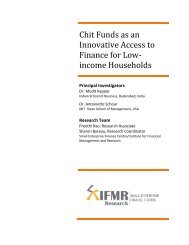Government of India Volume I: Analysis and Recommendations
Government of India Volume I: Analysis and Recommendations
Government of India Volume I: Analysis and Recommendations
Create successful ePaper yourself
Turn your PDF publications into a flip-book with our unique Google optimized e-Paper software.
FINANCIAL INCLUSION AND MARKET DEVELOPMENT<br />
Market development requires information gathering <strong>and</strong> analysis, which may be at<br />
the level <strong>of</strong> one sector, or on the scale <strong>of</strong> the full financial system. Inter-regulatory coordination<br />
is <strong>of</strong>ten called for. Market development may also require spending resources<br />
on market infrastructure that has public good characteristics. Such resources may be recovered<br />
from the financial service providers, <strong>and</strong> spent on market infrastructure based on<br />
a thorough underst<strong>and</strong>ing <strong>of</strong> costs <strong>and</strong> benefits. Market development may also require<br />
notifying regulations to bring market processes in line with international best practices.<br />
Accordingly, the Commission, after much debate on the objectives <strong>of</strong> regulators in<br />
the pursuit <strong>of</strong> development, recommends that the regulatory objective <strong>of</strong> development<br />
should translate into the following:<br />
1. Modernisation: The regulator should undertake measures that are necessary to modernise market<br />
infrastructure or market process, particularly measures with regard to the adoption <strong>of</strong> new<br />
technology.<br />
2. Enlarging consumer participation: The regulator should be able to pursue certain social goals<br />
which contribute to the welfare <strong>of</strong> the people more broadly. In particular, the regulator should be<br />
able to undertake measures that provide for the differentiation <strong>of</strong> financial products or financial<br />
services to specified categories <strong>of</strong> consumers, or that enlarge consumer participation in financial<br />
markets generally.<br />
3. Best practices: The regulator may undertake measures to align market infrastructure or market<br />
process with international best practices.<br />
Besides the measures that the regulator may undertake to pursue its objective <strong>of</strong><br />
market development, the Commission recommends that the Central <strong>Government</strong> should<br />
be able to direct a specific regulator to ensure the provision <strong>of</strong> specified financial services<br />
by specified financial service providers or to any consumer or class <strong>of</strong> consumers. The<br />
provision <strong>of</strong> services in this regard must be with a view to ensure effective <strong>and</strong> affordable<br />
access <strong>of</strong> financial services to persons who would ordinarily not have such access.<br />
The Commission acknowledges that there may be costs incurred by financial service<br />
providers in implementing such directions, <strong>and</strong> recommends that the Central <strong>Government</strong><br />
reimburse the cost <strong>of</strong> granting such access to the financial service providers.<br />
10.2. Institutional architecture<br />
The Commission believes that these questions <strong>of</strong> development <strong>of</strong> markets <strong>and</strong> financial<br />
inclusion create certain problems for public administration. As an example, consider an<br />
attempt at subsidising credit for agriculture, or an attempt at increasing the flow <strong>of</strong> credit<br />
into certain states. If this is done by a financial regulator, three problems are encountered:<br />
1. Hidden costs: When a regulation forces banks to give more loans to open a bank branch in a nonpr<strong>of</strong>itable<br />
location, this imposes a cost – a tax – upon other branches, <strong>and</strong> also depositors <strong>and</strong><br />
shareholders. Questions <strong>of</strong> institutional design are raised when the power to impose such costs<br />
on certain parts in society is given to unelected <strong>of</strong>ficials. Therefore, the Commission recommends<br />
that where there is a cost incurred by financial service providers in granting effective <strong>and</strong> affordable<br />
access to financial services, such financial service providers should be reimbursed in some<br />
form (for example, cash, cash equivalents or tax benefits).<br />
2. Dilution <strong>of</strong> accountability: There is considerable policy knowledge <strong>and</strong> experience worldwide<br />
about embedding principles <strong>of</strong> accountability into systems <strong>of</strong> consumer protection <strong>and</strong> microprudential<br />
regulation. There is less experience <strong>and</strong> information available with regard to accountability<br />
principles for market development or inclusion initiatives. For example, the number <strong>of</strong><br />
households that participate in a given financial product may be increased quickly by reducing the<br />
burden <strong>of</strong> consumer protection. Similarly, the function <strong>of</strong> redistribution to exporters, by requiring<br />
banks to give loans to exporters, is in direct conflict with the function <strong>of</strong> protecting consumers<br />
who deposit money with banks. Competing objectives can hinder accountability.<br />
3. Inefficiency: When a transfer is achieved by taxing some consumers in order to deliver gains to<br />
others, this is a form <strong>of</strong> taxation. The Commission believes such implicit <strong>and</strong> selective taxation <strong>of</strong><br />
different categories <strong>of</strong> consumers is inefficient.<br />
100 FINANCIAL SECTOR LEGISLATIVE REFORMS COMMISSION



